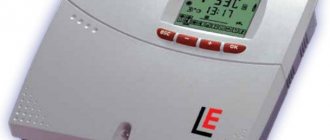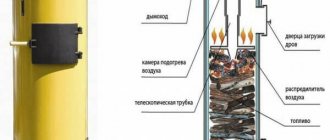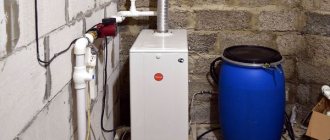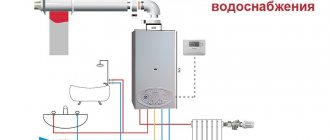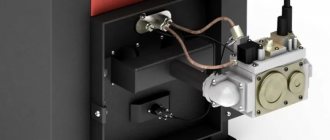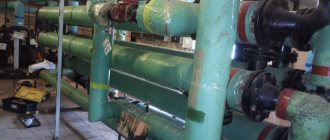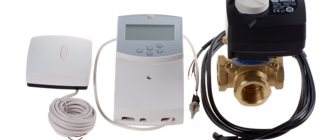ZONT SMART is a thermostat for remote control of a boiler with a built-in GSM modem. Commands can be sent to the device from any phone (satellite, mobile or fixed line), tablet or PC. Allows you to remotely change the operating parameters of the heating system and control the climate.
The main difference from the ZONT H-1V thermostat is only in the external design (mounting next to the boiler, and not on a DIN rail inside the boiler or plastic box), all functions and the ability to connect additional equipment are identical!
Using a thermostat, you can set the desired room temperature. At the same time, it is possible to switch to the fixed temperature mode “Economy” or “Comfort”, to the weekly programming mode “Schedule” or turn off the boiler.
The device independently monitors the temperature sensor readings and adjusts the operation of the boiler depending on the specified temperature parameters in the room. ZONT SMART is capable of transmitting service messages to the owner, reports on changes in boiler operating parameters and reporting abnormal situations.
Main functions of the ZONT SMART thermostat:
- Controls heating and domestic hot water via a digital interface via external adapters
- Controls air/coolant/street temperature
- Controls the boiler in weather-compensated mode and with a PID controller
- Controls radio sensors for various purposes
- Notifies in case of boiler failure, power outage and other events
- Reduces energy consumption (10 modes, including scheduled)
- Ideal for gas boilers
- Mounts to any surface and DIN rail
Additional functions of the device allow you not only to save resources on heating and monitor the proper operation of the heating boiler, but also to monitor the safety of the facility and instantly notify about emergency situations. The user can connect additional sensors, for example, motion, disconnection, water leaks, gas leaks, fire and smoke sensors, etc. Information is transmitted via mobile communications and the Internet.
ZONT SMART is a controller for any heating boiler with the ability to control its operation and remote control via the Internet and Cellular communications. Commands can be sent to it from any phone, tablet or PC.
For convenience, we recommend free applications for iOS and Android mobile devices, as well as a web service with access through your personal account. To protect against unauthorized access, access to your personal account is password protected.
Comfortable temperature is different for everyone. Some people love tropical heat, others believe that 20–22 degrees is more than enough.
We have provided several home heating modes so that you can select the one you need at the moment in one move.
In addition, you can easily create a weekly operating schedule for your heating boiler for the most optimal consumption of electricity or gas.
ALERTS SYSTEM FOR ALL OCCASIONS OF LIFE
The thermostat controls the temperature in the house and outside, supply voltage, technical condition of the boiler, the number of operating power stages and much more.
If the values deviate from the specified ones, it informs you about this with a call, SMS message, as well as a PUSH notification, if you have the application installed on your phone or tablet. The thermostat measures the room temperature and turns the output relay on or off, controlling the operation of the boiler so that the room temperature corresponds to the set value. It monitors the technical condition of the boiler and signals in case of an accident or power outage.
10 TEMPERATURE SENSORS FOR EVERY PURPOSE
The thermostat allows you to simultaneously connect 10 temperature sensors. These can be either wired or radio sensors. The cable length of wired sensors can be increased up to 30 m if necessary, and the ZONT module itself can be connected at a distance of up to 100 m from the boiler itself.
The main readings are used to control the operation of the boiler. An additional sensor is assigned to it as a reserve. If the main thermostat malfunctions, it automatically switches to operation using the backup sensor and control of the boiler does not stop.
The readings of the remaining sensors are used for general monitoring of the heating system.
Expert advice: how to protect yourself from controller breakdowns
Repair of control units for gas boilers is not a common occurrence.
However, before purchasing equipment from a certain manufacturer, ask if there are service centers in your region. To protect yourself from troubles at the wrong time, you should, with the help of specialists, inspect the boiler before and after the heating season. A network voltage stabilizer will help protect the electrical controller from pressure surges, thereby protecting the device from damage.
You can prevent possible damage to the control unit the first time it is put into operation. The unit system is complex and fragile in its own way; settings may be lost during transportation or assembly of the equipment. Therefore, during installation, they first carefully check all the subtleties associated with the wiring, water and gas supply, and then check the operation of the CU sensors.
The latest models of controllers have been brought to almost complete independence. The gas boiler control unit reports faults using indicators, as can be seen in the diagram below.
If you notice any failure, even a minor one, it is better to immediately call a boiler service specialist, this will prevent a serious breakdown and save yourself from more serious problems.
Advantages of control units
The main advantage is the optimally adjusted operating mode of the boiler, gas flow adjustment and the function of programming the desired mode. This is convenient when residents are often absent.
Modern controllers completely control the operation of the heating device and regulate the heating mode, taking into account weather conditions.
…
Almost all gas boilers are equipped with an external gas boiler control unit - a microcontroller, if it is not included in the package. This block allows you to set the operating mode for a specific period, for example, a week.
The control unit distributes heat flows to several water systems, which simplifies heating in houses and apartments. For example, adjusting the operation of a floor heating collector.
Having set all the necessary parameters with an accuracy of a degree, the user can eliminate himself; all errors and problems in the operation of the control unit are displayed on the display.
Operating principle of the control unit (controller) for boilers
Controllers are electronic devices that are designed to optimize the control of a gas heating device under changing environmental conditions. The capabilities and functions of different devices differ, but they are united by the presence of pressure and temperature sensors.
The electronic gas boiler control unit (ECU) is responsible for the operation of the gas burner, heating of the coolant and the safety of the system as a whole. Its operating principle is based on the use of an electromagnetic valve.
The controllers of the latest heating devices are equipped with an automatic mode function, which allows you to regulate the operation of the device during the week without human intervention.
Connecting the computer to external temperature sensors and boiler control terminals allows you to configure independent changes in the operation of the burner.
What is a control unit for a gas boiler
A gas boiler control unit (CU) is a device that regulates, optimizes and controls the operation of a heating device with maximum accuracy. This device is equipped with a function for programming specified operating modes, sensors that capture all changes in readings and supply this data to the control unit.
The main functions assigned to the boiler control unit:
- control of burner operation;
- gas supply regulation:
- providing heat supply;
- chimney draft control;
- turn off the gas supply if the maximum temperature is reached;
- turn on the gas supply at the minimum temperature mark.
The first pump-water heating device in Russia was tested in the early years of the 19th century when heating the Mikhailovsky Theater in St. Petersburg. After a successful experiment, the Hermitage, Mariinsky Theater and the Railway Engineering Institute were equipped with systems.
What does a controller provide for temperature control in heating systems?
The introduction of automated control tools using a heating system controller opens up a number of possibilities for the owner. First of all, heating control from a special heating boiler control panel becomes available. The thermostat is located in any place convenient for the user. Thanks to this, there is no need to go to the equipment located in the boiler room in order to change settings, turn it on or off. Heating automation also offers the following advantages:
- Automatic maintenance of user-specified temperature. Automation maintains the required indicator regardless of external conditions. These include heating of the building by the sun's rays, the presence of a large number of people on the site, and a decrease in outside temperature due to bad weather.
- Achieving significant savings in energy resources and fuel. Automation uses resources to maintain a given temperature more efficiently than a person. As a result, the boiler operates for less time, heating is more efficient, wear of parts is slowed down - the service life is extended.
- The ability to remotely control the operation of heating equipment, for example, using a gsm heating controller. Properly configured automation allows the user to turn on, turn off and configure the boiler while being at a great distance from it. It also opens up the opportunity to quickly respond to emergency situations.
Automated heating can be interfaced with the Smart Home home automation system. In this case, the possibilities for adjusting the microclimate in the building become as wide and flexible as possible. This is achieved through the use of multiple temperature and humidity sensors located in all rooms of the house. Installation of actuators is also available to improve system security.
Due to the large number of advantages of automated control of a country house or cottage, the question does not arise about whether it is worth buying a heating boiler control panel or, for remote control, a gsm heating controller. This step is costly, but will ultimately lead to savings in money and time during the operation of heating equipment. It will also bring you many conveniences.
Heating system controllers
This Privacy Policy is an integral part of the User Agreement of the Site and applies to all information, including the User’s personal data, received by the Site Administration during the User’s work with the Site, execution of the User Agreement and agreements between the Site Administration and the User. Use of the Site means the User’s unconditional consent to this Privacy Policy and the conditions for processing his personal data specified therein; in case of disagreement with these conditions, the User must refrain from using the Site.
Before using the Site, the User must carefully study this Privacy Policy.
1. PERSONAL DATA
1.1. Providing in any form (registration on the Site, placing orders, subscribing to advertising mailings, etc.) his personal data to the Site Administration, the User agrees to the processing of personal data by the Site Administration in accordance with the Federal Law “On Personal Data” dated July 27, 2006 No. 152-FZ.
1.2. The processing of personal data is carried out for the purpose of fulfilling the User Agreement and other agreements between the Site Administration and the User.
1.3. The processing of personal data is carried out exclusively on the territory of the Russian Federation, in compliance with the current legislation of the Russian Federation.
1.4. The User's consent to the processing of his personal data is given to the Site Administration for the period of fulfillment of obligations between the User and the Site Administration under the User Agreement or other agreements between the User and the Site Administration.
1.5. In case of withdrawal of consent to the processing of the User’s personal data, the User notifies the Site Administration in writing or by email. After receiving this notification, the Site Administration stops processing the User’s personal data and deletes it.
1.6. The site does not have the status of a personal data operator. The User's personal data is not transferred to any third parties, except as expressly provided for in this Privacy Policy.
2. MEASURES TO PROTECT PERSONAL DATA
2.1. In its activities, the Site Administration is guided by the Federal Law “On Personal Data” dated July 27, 2006 No. 152-FZ.
2.2. The site administration takes all reasonable measures to protect the personal data of Users and respects the rights of personal data subjects established by the current legislation of the Russian Federation.
2.3. The protection of the User's personal data is carried out using physical, technical and administrative measures aimed at preventing the risk of loss, misuse, unauthorized access, violation of confidentiality and modification of data. Security measures include firewall protection and data encryption, physical access control to data centers, and data access permission control.
3. CHANGES TO THE PRIVACY POLICY
3.1. The site administration reserves the right to unilaterally make any changes to the Privacy Policy without prior notice to the User. The current text of the Privacy Policy is posted on this page.
Tips for organizing remote heating control
Connection diagram of modules to the heating control unit
In most cases, you can make a cottage heating control system yourself. This is only possible with the correct selection of system components. Those. First you need to analyze the condition and capabilities of the already installed equipment.
The classic heating system control unit diagram has one control unit, which is connected to all heat supply elements. The programmer must meet the following requirements:
- The number of connected terminals and their configuration must coincide with similar communication nodes of the boiler and thermostats. Otherwise, heat supply control via SMS will be impossible. If necessary, adapters are purchased;
- Maximum distance of the user from the control unit. If this distance does not exceed 300 m, you can purchase models with mine control. To increase the communication area, it is recommended to use heating control via a mobile phone or the Internet;
- The ability to independently (or with the help of specialists) set additional operating parameters. This is done with a controller based on heating control boards;
- Connecting an autonomous power supply unit. To do this, you need a sufficiently large heating control box. This parameter is taken into account when choosing the installation location of the control unit in the house.
Don't forget about the ability to control heating radiators. This can be done using local devices - mechanical thermostats. They are low cost, but cannot be connected to a common electronic control system.
The most common breakdowns in the control unit
Since the control unit is a whole system, a failure can occur from any deviation of a component of this system. The most common malfunctions and their causes :
- the burner went out - air got into the gas pipeline;
- heating problems - poor gas supply, lack of oxygen;
- boiler overheating - closed contacts, prolonged operation at high temperatures, factory defective sensors;
- breakdown of the pneumatic relay (draft sensor) - incorrect connection, fan breakdown, incorrect smoke exhaust system;
- breakdown of the temperature sensor - incorrect connection of contacts, short circuit, overheating of the board;
- breakdown of the pressure switch - low water pressure in the pipes, defective contacts in the circuit board.
Most of these problems are easily fixed, even described in the instructions, but some require the intervention of a specialist.
You should not replace sensors or other parts yourself - this can be dangerous.
How does a controller work to control a heating boiler?
The boiler controller is the central node in the entire system. It sends signals to each of the elements and mechanisms, as a result of which the cyclic operation of the system is determined, and the parameters of all devices connected to it are changed and adjusted. In addition, it has a function for connecting to GSM-Monitor, which allows monitoring and regulation remotely and via the Internet. In case of failures or malfunctions, the boiler control controller will instantly turn off all components, and send a notification to the owner of the house on his mobile phone.
Any boiler control controller is a small electronic panel with which parameters are set and some functions are programmed depending on the data that comes from pressure or air temperature sensors.
The burner control controller regulates its operating mode and automatically records statistical data, which can be stored in the memory of the built-in computer for up to 20 years (depending on the controller model). The warning system is activated by an audible signal, indicating a problem or dangerous situation. The heating boiler will be turned off to avoid an accident. The controllers have a function to return to factory settings. As a rule, they involve automatically adjusting the fuel supply, maintaining a comfortable room temperature, and igniting the boiler. Automatic parameters are set based on the average air temperature and humidity in a particular region, which allows the user to ensure a comfortable microclimate in the room without unnecessary knowledge.
Purpose of devices
- monitor the operation of the heating system;
- control the temperature in the room;
- send reports on operating parameters;
- inform about changes in indicators;
- in the event of an emergency, autonomously turn off the system;
- function as a smart thermostat.
Applications have been developed for mobile phones (smartphones) to help control the device from a distance. The user does not need to be nearby to configure settings, but some devices have keys and an LCD display that can be used to change operating parameters.
Purpose of heating controllers
The main purpose of this electronic device is to change the parameters of control devices connected to it to correct their operation. The simplest example of an elementary control element of this kind can be considered an automatic control protection system in gas boilers. But controllers for heating and hot water supply have wide functionality.
They are an electronic unit with the ability to control the main elements of the heating system. To do this, it provides the ability to program parameters depending on the data received, from external temperature and pressure sensors. Thus, a controller for a heating boiler can regulate the operation of a heated floor collector or individual thermostats on radiators.
The general characteristics of electronic control units include the following:
- System flexibility. To connect to heating components, you do not need to reprogram the device. In most cases, manufacturers provide several operating modes for one connection terminal;
- Possibility to choose a convenient location for installing the control panel. The Honeywell heating controller can be mounted at a distance of up to 100 m from the control element;
- Monitoring the functioning of not only heating systems, but also hot water supply;
- If you have a GPS unit, you can receive data online about the state of the heating and send commands to change its parameters.
The function of connecting the device to a computer is also important. A similar additional module is installed on the Aries heating controller. It is noteworthy that it is not included in the required package.
Operating principle and automation functions for solid fuel boilers
Pre-installed automatic control unit on the TT boiler.
Automatic control can be either volatile or non-volatile. In modern solid fuel models, a non-volatile option - a draft regulator - is installed from the factory and operates on the principle of expansion when heated: the heat-sensitive metal heats up as the temperature in the boiler rises and mechanically closes the ash pan, reducing the intensity of combustion (and vice versa).
The energy-dependent option (requiring connection to the mains) is more efficient and multifunctional. A standard automation kit for solid fuel boilers consists of two main elements:
- fan - installed at the bottom of the boiler, on the air supply door (blower) or ash pan, used to pump air into the combustion chamber. The intensity of combustion depends on the volume of incoming air.
- controller – an electronic control unit that sets the fan rotation speed. At maximum rotation speed, the maximum volume of air is supplied to the combustion chamber and the most intense combustion is maintained. When the minimum temperature requirements are set, the blower speed is maintained at a minimum or it is assumed to stop completely.
The controller and fan can be purchased either as a ready-made kit or separately. However, they only work in pairs. Also, most controllers support control of a circulation pump, a smoke exhauster, it is possible to control using a room thermostat, and organize weather-dependent control. The most functional models have a built-in GSM module.
Ready-made complete automation kit.
As a result, the functions of the automation kit are:
- increasing the efficiency of fuel combustion (boiler efficiency) by controlling the blower;
- stable maintenance of the set temperature or its change depending on the specified settings of the room thermostat;
- automatic ignition (optional, with igniter);
- increasing the burning time of one load of fuel.
There is no division by type of fuel used. One set of automation can work with both a coal, wood or pellet boiler.
Automatic fuel supply
Separately, it is worth highlighting automatic fuel supply systems; their operation can also be controlled by some of the controller models. An autoloading system is, most often, a bunker with fuel (wood, coal, pellets, peat) installed on the boiler or next to it. Fuel can be supplied from it by means of: an embankment (falling under the weight of its own weight), an auger (a gear-screw mechanism), a conveyor belt. In any case, the feed system is controlled by the controller.
The use of an automatic feeding system solves the issue of low autonomy, since one loading of the bunker is enough for continuous operation of the boiler for 2-30 days, depending on the volume of the bunker and the intensity of combustion.
Are pellet boilers with automatic fuel supply worth the money?
Automation design
All internal equipment of automation for gas boilers, which is used when installing a heating system, can be divided into categories, there are only two of them:
- the first category is those devices that ensure the safe and proper operation of all boiler equipment;
- the second category is those devices that can significantly increase the comfort when using the boiler.
Safety automation for gas boilers consists of the following elements:
- the module that provides flame control. It consists of a thermocouple and a gas valve that works like an electromagnetic valve and shuts off the fuel supply;
- there is also a device that protects the system from overheating and maintains the required temperature; this task is performed by the thermostat. It independently, if necessary, turns on or off the boiler at those moments when the temperature approaches the specified peak levels;
- the sensor that controls traction. This device works based on vibrations depending on how the position of the bimetallic plate changes. It, in turn, is connected to a gas valve, which stops the gas supply to the burner;
- there is also a safety valve, which can be responsible for discharging excess coolant (for example, air or water) in the circuit. Some manufacturers immediately provide an element that helps dump excess.
The devices included in the security system are divided into the following types:
- mechanical;
- and operating from a power source.
Automation provides the user with more comfortable functionality, which is additional:
- automatic ignition of the burner;
- flame intensity modulation;
- self-diagnostic functions.
But such functionality is not limited to the internal design of the models.
Some design features of the models include additions such as sending data and processing it by an electronic system on equipment equipped with controllers and microprocessors. Then the following situation occurs: based on the received data, the controller itself begins to adjust the commands that activate the machine’s system drives.
Mechanical automation of a gas boiler also requires detailed consideration.
- The gas valve is completely closed and the heating installation is inoperative.
- In order to start a mechanical gas boiler, the washer is squeezed out, allowing the fuel to start and opening the valve.
- The valve opened under the influence of the washer and gas flowed to the igniter.
- Ignition is in progress.
- After this, gradual heating of the thermocouple begins.
- The electric shut-off magnet is supplied with a voltage that ensures its open position so that fuel access is not blocked.
- Mechanical rotation of the washer regulates the required power of the gas heating device, and the fuel in the required volume and with the required pressure is supplied to the burner itself. The fuel ignites and the boiler unit begins to operate.
- And after that, this process is controlled by a thermostat.
Selecting a heating controller
In what cases is it necessary to install a heating control controller? First of all, this device is necessary when residents are often absent from the house or apartment. By connecting the electronic unit to external temperature sensors (outside and indoors) and the boiler control terminals, you can use the built-in software to set up an automatic change in the intensity of the burner operation.
How to choose the optimal controllers for heating systems? The easiest option is to consult with specialists. But nowadays it is difficult to find one, since this product is relatively new. Therefore, it is recommended that you first study the basic selection parameters yourself:
- When comparing a controller for a heating boiler, you should make sure that the installed equipment has the ability to connect to the control unit. Most often, the boiler is characterized by one-stage or two-stage external control. This applies only to gas models - coordination with solid fuel models is impossible;
- Number of managed components. For a Honeywell heating controller, this value can reach 15 depending on the specific model;
- Availability of GPS unit. As mentioned above, this function makes it possible to remotely control the heating;
- Software update frequency. The modern controller of heating and hot water systems TRM 32 can be connected directly to a computer. You can always find the latest software version on the manufacturer's website.
An additional function is to adjust the operation of the components according to the configured heating schedule. This feature is provided in the Aries heating controller
You should also pay attention to the accuracy of measurements. In professional models, this indicator should not exceed ±0.01 scale
Weather-compensated controllers
Weather-dependent control of boiler equipment is a modern and effective way to achieve additional energy savings. The essence of this solution is that the temperature of the coolant depends on the air temperature outside, and as a result, on the heat loss of the room - the lower the temperature outside, the hotter the coolant, and vice versa, the warmer it is outside, the lower the temperature in the heating system. Recently, this method of heating control has become more and more of interest to customers, and manufacturers of both boiler equipment and automation are not standing still, developing new solutions and algorithms for weather-dependent control of heating systems.
Most modern boilers have the ability to connect an external temperature sensor and change the coolant temperature in the entire heating system according to their own weather-dependent algorithm. But what to do if the customer already has a boiler without this option (or, in order to save money, purchases a simpler boiler model), and one or more heating circuits require weather-dependent regulation?
Our company - Heating Automation Center termostat.pro, offers a simple, ready-made solution for such situations - controlling the temperature of the medium in each specific heating circuit, without interfering with the boiler automation.
Weather-dependent thermostats and controllers SALUS Controls and EbV electronik control the drives of 3-way valves of heating circuits and their pumps and ensure the maintenance of the medium temperature specified by the user in the “weather-dependent curve” - a graph reflecting the values of the medium temperature depending on the outside temperature.
You can connect room thermostats to the controllers (if the circuit heats one room) or switching center outputs (if the circuit provides heating to several rooms, and each has its own room thermostat). When the air temperature in the room reaches the user-specified temperature on the room thermostats, the controller will reduce the temperature of the medium in this heating circuit by a certain amount - which also leads to additional savings.
The devices of EbV electronik and SALUS Controls have different valve and pump control algorithms, depending on what heating equipment is connected to the circuit - radiators or heated floors. For heated floors, special commissioning modes are programmed to ensure uniform heating of the screed.
The weather-dependent controllers supplied by our Heating Automation Center can also be connected to a heat source in the system - a boiler; if both the air temperature in the room and the temperature of the medium in the heating circuit are reached, the boiler will turn off. This connection can only be used if all heating circuits in the system are connected to our controller.
Weather-dependent controllers have the ability to control several heat sources - the main and backup ones; the control algorithms include several typical hydraulic circuits, using various types of boilers (including solid fuel), heat accumulators, solar collector circuits and their combinations. With the help of additional modules it is possible to control cascades of boilers.
The use of weather-dependent controllers ensures accurate and efficient temperature control in the heating circuits of your system, and most importantly, comfort and savings.
Product
Qty
Price
— Buy weather-compensated SALUS automation for a boiler room in Moscow with delivery
— Price for boiler automation heatcon! from 20,000 rub.
— Buy weather-compensated automation in the online store
Wired switching center Salus KL06.
Costs 4281r.
The KL06 controller is designed to connect thermostats and actuators into a single switching unit. There is an indication of the state of the servos.
Control of the pump and boiler is possible only after connecting additional modules Salus PL06 or PL07 (1700r and 2800r).
If you carefully read the Salus KL06 instructions, you will find out that this is a more cunning device than it might seem.
Fully functional with Salus thermostats.
PWM, VP, NSB SYSTEMS
The systems used in Salus ERT series thermostats provide more efficient control of floor heating.
PWM
Due to the high inertia of floor heating, the use of the PWM system in ERT series controllers guarantees us precise maintenance of a constant temperature in the rooms. The PWM system controls the operating time and the opening and closing frequency of the used servomotors in relation to the rise in room temperature. The result is additional savings, comfort, and no overheating of the room.
V.P.
This is a system that protects and extends the life of servomotors. Opens and closes the servomotor once a week, even if the system is not currently operating (outside the heating season).
NSB.
Temperature reduction function - NSB (Night Set Back). The system provides the ability to influence the temperature depending on the time of day, which guarantees efficient control of the heating system. The temperature reduction function allows you to reduce the temperature by 4°C, without adjusting the thermostat, even with non-programmable controls in most zones.
The NSB function in the regulators is activated by an external signal transmitted to the Salus KL06 bar using the Salus ERT50 weekly thermostat. This regulator must be connected to the field marked number 1.
All regulators must be connected using a 4-wire wire, according to diagram number 1.
If you do not enable the clock field, the MSB function will not be active, but the other controller functions (PWM and VP) will work.
Here are the connection diagrams for thermostats.
The connection diagram for the ST320 thermostat is unusual - let's see what's in the datasheet of this thermostat.
It seems that the thermostat controls exactly 220V, passing or not passing through itself. If so, then the Salus KL06 controller may be suitable for working with thermostats that provide 220V for load control.
I don’t like it visually, and with a pump and boiler connection module it costs more than 6000 rubles and has open terminals. I will not have Salus thermostats, so the “smart” functions are not available.
Device Description
The described device has a number of other capabilities:
- The module informs the owner of the house about the interruption of gas or electricity supply.
- If an error occurs in the operation of the heating boiler, the owner receives a message.
- The control unit also signals the owner about a gas or coolant leak from the system.
- In the absence of family members in the house, the heating system can be programmed to use energy economically. To do this, a command is given to the control module using a message or call.
- The owner of the house, with the help of a call or message, has the opportunity to receive up-to-date information about the condition of the boiler and other system parameters, as well as clarify the temperature of the coolant and air in the house.
Let us consider in more detail the operating principle of GSM heating control using the example of the domestic complex “XITAL GSM-4T”.
INDIVIDUAL SETTING OF OPERATING MODES
Comfortable temperature is different for everyone. Some people love tropical heat, others believe that 20–22 degrees is more than enough. We have provided several home heating modes so that you can select the one you need at the moment in one move. In addition, you can easily create a weekly operating schedule for your heating boiler for the most optimal consumption of electricity or gas.
CHARACTERISTICS OF TEMPERATURE CONDITIONS
| Economy | Why heat the house when everyone is at work? Use this mode and save up to 15% energy daily by setting the minimum temperature to keep the room warm (for example, +15 degrees) |
| Comfort | Set a temperature that is comfortable for you and use this mode when you are at home (when the temperature drops a couple of degrees, the boiler will turn on to heat to the specified value) |
| Anti-freeze | If you move to a city apartment in winter, set this mode and don’t worry about the heating system at home - it is under reliable protection. |
| Schedule | Make a weekly heating schedule for your home and it will be cozy and warm every day (you can set the minimum temperature during the hours you are not in the room, and also set it to warm up to a comfortable temperature by the time you arrive). |
EASY INSTALLATION, NO SPECIAL SKILLS REQUIRED
ZONT SMART easily connects to an electric or gas boiler instead of a room thermostat. A SIM card of any operator that provides stable reception is inserted into it, supply voltage is supplied and a temperature sensor is connected. The controller automatically controls the operation of the boiler and informs the owner in all available ways.
| TECHNICAL CHARACTERISTICS OF THE ZONT SMART THERMOSTAT | |
| Supply voltage | 24V |
| Maximum current consumption | 1000 mA |
| Number of analog inputs | 1 |
| Output dry contact (make/open) | 1 |
| Type of connected wired temperature sensors | DS18S20, DS18B20 |
| Type of connected radio thermal sensors | ML-740, ML-711, ML-719 |
| Total number of simultaneously connected temperature sensors | 10 pieces. |
| Maximum permissible length of cable with temperature sensors | 100 m |
| Maximum current through relay contacts | 1000 mA |
| Maximum voltage of switched relay contacts | ~ 120 V, = 24 V |
| Voice interface | There is |
| WEB interface | There is |
| 1-Wire interface | There is |
| Operating temperature range | from -30 to +55 °C |
| GSM modem frequency ranges | 800, 900, 1800, 1900 MHz |
| Data link | GPRS |
| GSM antenna | external |
| Internal non-volatile memory | There is |
| Built-in battery backup | Li-ion / 1000 mA*N |
| Time to reach operating mode | no more than 50 sec |
| Average service life | 7 years |
| dimensions | 150 x 130 x 30 mm |
| Weight, no more | 0.300 kg |
| Housing material | ABC plastic |
| TECHNICAL DOCUMENTATION FOR THE ZONT SMART MODULE | |
| Operating instructions ZONT SMART (PDF, 1.1Mb) | |
Monitoring the condition and controlling the operation of the boiler via a web service and the ZONT mobile application
- Attention! When powered by a backup battery, the thermostat does not control the boiler!
- Display of the current state of the boiler;
- Display of current and target room temperature (coolant);
- Creation of individual boiler operating modes (up to 10 different modes);
- Monitoring of measured temperatures (air, coolant, hot water);
- Programming the boiler operation according to a weekly schedule;
- Monitoring the status of additional sensors (leakage, pressure, gas leakage, security).
Boiler owner notification
- when the current temperature deviates from the threshold values set by the operating mode;
- in case of an accident or malfunction of the boiler;
- if the connected temperature sensors are faulty;
- in case of loss and restoration of the main supply voltage (mains);
- when additional security sensors are triggered (the “Security Alarm” function).
Recording and storing event history (for the last 3 months)
- boiler operating time and monitoring of measured temperatures;
- time of occurrence of accidents and errors in the operation of the boiler;
- time of loss and restoration of the main supply voltage;
- time of incoming calls and text of incoming SMS messages;
- software update date and current software version number.
Primary sensors
Their task is to signal the operating parameters of the boiler.
In other words, the sensors transmit indicators to the control unit, which makes a decision about the need for one or another action.
Let us immediately clarify that not every gas heating boiler has all of the sensors listed below as standard. Their availability depends on the model. Coolant temperature sensor. Helps the controller regulate the burner flame. As a rule, a gas heating boiler has two such sensors: one monitors the temperature of the liquid at the outlet of the heat exchanger, the other signals how much the coolant has cooled in the return pipe (“return”) after passing through all the heating devices in the house. The resulting temperature difference (ΔT) allows the controller to issue a command to increase or decrease the intensity of the gas burner, up to turning off the boiler.
Flame sensor. The full name of this device - “flame sensor on the burner” clearly explains its purpose. If the torch goes out, the sensor will give a signal and the controller will take action to re-ignite or, in the event of a malfunction, completely turn off the boiler.
How does the flame sensor work in advanced models?
If the gas heating boiler has a more complex controller, then the flame sensor helps to combat such violations as “separation” and “breakthrough” of the flame. In both cases, the torch is in the wrong position, this leads to uneven heating, which causes the heat exchanger to fail. Flame separation is a phenomenon in which fuel combustion occurs not at the burner, but at some distance from it; This is due to excess gas pressure. Insufficient pressure leads to a breakthrough: the torch “goes” into the pipe, and the fuel burns even before the burner, which can damage the gas pipeline.
Exhaust gas analyzer. It controls the composition of the atmosphere in the chimney: deviation of the mixture of gas and air from the norm leads to the formation of free carbon (soot) and hydrogen, the presence of which is recorded by the analyzer. Based on its readings, the controller changes the parameters for preparing the mixture, usually by increasing or decreasing the gas supply. This sensor is usually found in advanced gas heating boilers.
Putting the module into operation
Configuring and enabling the module is usually carried out in the following sequence:
- connecting the module to the heating boiler controller;
- installing a SIM card, entering a pin code;
- Next you need to set the pin code to the controller. This is necessary to protect identification in SMS messages;
- entering all registered numbers;
- sending a pin code to the controller’s SIM card - in response you will receive a message about the current parameters of the boiler and sensors.
If you need to change some parameter (for example, the boiler temperature), enter the code again, then the desired temperature. The response will contain confirmation of the new settings. This means that the GSM module is activated and put into operation.
How is connection and operation carried out?
It is possible to control gas, diesel and electric heating boilers. No special knowledge is required for setup and installation, and control after initial setup is performed with just a few simple commands. To connect the device, you need to connect the module to the boiler input for room thermostats, install a SIM card in the device and send a command to bind the device to your phone number. After this, the controller is ready for use.
To buy GSM for heating boilers in Moscow and St. Petersburg, call or write to us at the Telemetrics online store: our products can be purchased in different regions of Russia, including through pick-up points.
Principle of weather-compensated heating control
Let us explain how room temperature is maintained taking into account changes in outside temperature. When setting up the controller, a so-called temperature curve is established, reflecting the dependence of the temperature of the coolant in the heating circuit on changes in weather conditions outside. This curve is a line, one point of which corresponds to +20°C outside (in this case, the temperature of the coolant in the heating circuit is also +20°C, since it is believed that under such conditions there is no need for heating). The second point is the coolant temperature (say, 70°C), at which even on the coldest day of the heating season the temperature in the room will remain set (for example, 23°C). If the building is not insulated sufficiently, a slightly higher temperature of the coolant in the heating circuit will be required to compensate for heat loss. Accordingly, the slope of the curve will be steep. And vice versa, if everything is in order with the thermal insulation of the house. When making a controller, many similar curves are entered into the device’s memory so that you can then select from the entire family the appropriate line specifically for the conditions of your home.
As a rule, to create the maximum level of thermal comfort, as well as to save fuel, a single street sensor is not enough. Therefore, an additional sensor is often installed inside a heated room. The presence of two sensors at once, both indoor and outdoor, allows you to accurately monitor and quickly adjust the temperature in the premises of the house.
Typically, a room temperature sensor is installed in the so-called reference room - the temperature in it will correspond to your concept of a comfortable thermal background. This room should not be heated by direct sunlight or exposed to drafts. As a rule, children's and bedrooms are chosen as a standard. Installing a room sensor makes it possible to enable the self-adaptation mode, in which the heating curve is selected for the appropriate room automatically - by the microcomputer of the control panel itself. In addition, a room sensor is often integrated into a thermostat, with which you can set the desired temperature and its average level throughout the house. Local temperature control in a single room is achieved by installing thermostatic valves with thermal heads on radiators.
A very important aspect of using a thermostat is, again, fuel economy. Let us explain how it is carried out. Let’s say that guests gathered in the room where the sensor is installed and the temperature increased by 2°C due to the natural heat generation of people. The control panel detects these changes and gives a command to reduce the temperature of the coolant in this circuit, although the street sensor may require just the opposite. Reducing the heat consumption to heat this room naturally saves fuel. But there are also problems here. Flooding the fireplace in the room where the thermostat is set, or leaving a window open for too long, can change the temperature throughout the house. To take into account such factors, many systems provide the possibility of making amendments to the control algorithm by setting the coefficient of influence of the room sensor on the nature of the heating curve. But in general, experts simply do not recommend installing room temperature measuring devices near fireplaces, entrance doors, windows and other sources of heat or cold that can introduce an error in the measurement results.
It should also be noted that installing only a room thermostat, without an outside temperature sensor, significantly increases the inertia of the temperature control system. Changes in the thermal background will occur with a delay, since the automation will begin to operate only when the temperature in the house, for example, drops, and this will happen later than the actual cold snap outside. Modern controllers not only monitor the weather, but also have a fairly large number of functions, some of which are user, and some are service
If the former guard comfort, the latter monitor the condition of the system and ensure the correct and safe operation of the equipment.
Modern controllers not only monitor the weather, but also have a fairly large number of functions, some of which are user, and some are service. If the former guard comfort, the latter monitor the condition of the system and ensure the correct and safe operation of the equipment.
Advantages of heating and hot water system control
Positive aspects of using this device:
- the automatic system makes it possible to set the temperature of hot water supply at a given level;
- energy saving;
- the controller is able to regulate the required temperature of the heating and hot water supply system depending on the time of day (day/night), season and according to any schedule specified by the user;
- an established operating scheme of the entire system reduces the likelihood of pump wear;
- the controller maintains a constant temperature in the return pipeline in accordance with the specified schedule, thereby eliminating the possibility of receiving a fine for exceeding it;
- The replenishment of the heating circuit is brought to automaticity according to the data of the heating network pressure sensor;
- well-established operation of an alarm signal in case of deviation from the specified readings of pressure sensors in networks, temperature conditions, and electrical protection.
How to choose automation for a solid fuel boiler
The best automation for a solid fuel boiler is a properly configured and selected control unit and the optimal power of the fan turbine, which depends on the rated power of the boiler's TT, the volume of the combustion chamber, the height and diameter of the chimney.
In order to choose automation for a boiler, you need to know its rated power, the number of circulation pumps in the heating system and the type of ventilation turbine you have or which one you want to purchase: a blower fan or an exhaust fan.
Our specialists will help you choose the right automation kit for your wood, pyrolysis or pellet stove, with automatic or mechanical fuel supply.
Contact us in any way convenient for you, by phone: or via instant messengers: WhatsApp Telegram
Operating principle of the control unit (controller) for boilers
Controllers are electronic devices that are designed to optimize the control of a gas heating device under changing environmental conditions. The capabilities and functions of different devices differ, but they are united by the presence of pressure and temperature sensors.
The electronic gas boiler control unit (ECU) is responsible for the operation of the gas burner, heating of the coolant and the safety of the system as a whole. Its operating principle is based on the use of an electromagnetic valve.
The controllers of the latest heating devices are equipped with an automatic mode function, which allows you to regulate the operation of the device during the week without human intervention.
Connecting the computer to external temperature sensors and boiler control terminals allows you to configure independent changes in the operation of the burner.
Automation kit for solid fuel boiler.
We can offer you to buy an automation kit for a solid fuel boiler cheaper than buying its components separately. Automation kits include an electronic heating boiler control unit and a blower or exhaust fan.
Consultations on the selection and installation of automation on a solid fuel boiler and its subsequent configuration. You can get professional advice on selecting a controller for your solid fuel boiler immediately before purchasing by calling the phone number listed on the website or filling out the call back form.
We will call you back, answer all your questions and provide all information support on connecting and setting up the command controller for your solid fuel boiler.
You can also quickly contact us through WhatsApp and Telegram messengers. Click on the link or messenger icon and right now you can ask your question about our products or get advice regarding the automation of your TT boiler.
District heating control
Heating control unit in an apartment building
For district heating, the control scheme will be much more complex. It may include several units - an equipped heating control cabinet in the central boiler room, a coolant distribution unit in an apartment building.
In this case, heating control via the Internet is practically not used. Exceptions are heat meters, which transmit coolant flow readings directly to the management company.
In turn, it is not important for the consumer to know the features of the heating control arrangement. Each heat consumer in an apartment building must be familiar with the standards for providing heat supply to residential buildings:
- Temperature range in residential premises – from +18 to +22°С;
- Possible excess heating should not be more than 4°C;
- Temperature reduction – not lower than 3°C.
If these readings are outside the norm, you must contact the management company. Systematic violation of the heating operating mode may be due to outdated control equipment. The only solution is to install an electronic centralized heating control unit.
An example of installed heating control can be found by watching the video:
https://youtube.com/watch?v=cn7L52LH-Ic
What is automation for a solid fuel boiler?
Automation of a solid fuel boiler allows you to save almost a third of the fuel burned, be it coal, firewood, briquettes or pellets, maintaining a comfortable temperature in a residential or industrial premises.
Unlike a mechanical thermostat or draft regulator, which react to the temperature of the coolant, electronic automation for a TT boiler is guided by the temperature in the living room.
Data from the temperature sensor enters the boiler control unit and, based on it, the microprocessor controls the combustion chamber damper drive, the exhaust or blower fan, and the circulation pump for the coolant. It is possible to control the hot water supply circuit of the house or additionally control the boiler.
Automation for the boiler will allow you to save up to 30% of fuel. A customized boiler control system will increase its efficiency even when loading raw firewood, coal, pellets and other fuels.
Features of use in a private home
Their presence is explained by the fact that in such buildings two-pipe systems are used. A circulation pump pumps liquid into them, which is supplied through a distributor to each heating device.
Photo 1. Possible heating scheme for a private house from an induction boiler with a controller.
In such cases, a safety unit is used with the controller to protect the heating system from various emergency situations. Additionally, liquid (coolant) flow control sensors and special valves are also used.
You can use thermostatic valves or room temperature controllers in your home. The first allows you to set the desired mode for any source, and the second is responsible for the operation of the pump that supplies coolant to the radiator.
If there is no Internet in a private home, then a GSM module is used, which allows you to control the situation via a smartphone.
How to connect the controller to a heating boiler with your own hands
Pay attention to the nuances when installing the controller:
- avoid its contact with direct sunlight;
- isolate from all electrical appliances;
- carry out the process at a height of at least 1.5 m from the floor;
- ensure a constant flow of air, avoiding drafts.
You can connect the controller yourself in two ways:
- using a terminal on the boiler;
- using the regulator cable.
Important! This process should not be carried out in the kitchen or bathroom, since due to a possible increase in temperature, malfunctions of the thermostat are possible. Almost every boiler has special contacts for connecting a controller to it
You need to find this place and remove the jumpers and connect the thermostat. How to set up the device itself and start working is indicated in the instructions
Almost every boiler has special contacts for connecting a controller to it. You need to find this place and remove the jumpers and connect the thermostat. How to set up the device itself and start working is indicated in the instructions.
Connecting automation to a solid fuel boiler
The installation process begins with a fan, which is installed on the air supply door or ash pan. Many modern solid fuel models already have places and holes for mounting the supercharger. Otherwise, you need to drill the holes yourself and secure the boost fan with four bolts.
Please note the presence of a heat-resistant gasket: it is required, but not available on all fan models. As a result, the turbine should be installed in accordance with the photo below.
Properly installed boost fan.
The second step is the installation and connection of the automation itself to the solid fuel boiler. The controller is installed on top or on the side of the case through the device holes intended for this purpose. Despite the fact that the body of many controllers is made of heat-resistant materials, it is advisable to install the device on the coldest part of the boiler body, if necessary, placing a heat-resistant gasket made of non-flammable material.
All that remains is to connect all the elements and connect the controller to the power supply. A detailed connection diagram is always indicated in the automation instructions, for example, this is what the connection diagram to the Komfort ECO control unit looks like:
Automation connection diagram using Komfort ECO as an example.
How to set up
The detailed setup algorithm also depends on the model and is always described in the instructions. In general terms, the setup implies the following procedure:
- Setting the temperature for turning on the circulation pump - allows you to turn on the pump not immediately, but when the coolant has already warmed up, it is necessary to prevent the formation of condensation (usually set to 50°C).
- Setting the desired temperature of the heating circuit or room air, depending on the model and controls.
- Setting the fan rotation speed (from 1 to 10) or selecting one of the automatic fan speed control modes. When setting the boost completely manually, you also need to set the parameters for the fan operating time and the frequency of its activation in combustion support mode.
- Adding fuel and igniting the boiler. Monitoring its operation and, if necessary, adjusting parameters.
In some models, you can also program operation for a day or a week in advance, set a temperature threshold, after which the fan will begin to gradually reduce speed, etc.
InstructionsBoilersSolid fuel boilers
"SMART HOMES"
The concept of a “smart home” involves centralized control and interaction of several systems simultaneously. To create comfort in a room, temperature alone is not enough; you also need to take care of the ventilation or air conditioning system and air humidity. Some elements that involve the joint operation of heating with other systems can be controlled by some standard controllers, for example, when connecting window opening sensors, you can program the heating of rooms to be turned off when ventilating.
Elements of heating systems from different manufacturers communicate with each other using different protocols and using different buses - in short, they “speak different languages.” To integrate “smart heating” into a “smart home”, most likely, you will need an interface module (gateway) for the heating installation controller, connecting it with other systems not related to heating equipment. The advantages of simultaneous control of all home systems, and not just heating, are obvious; it all depends on the complexity of the system.
